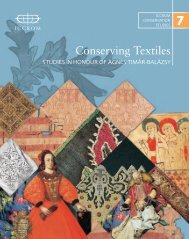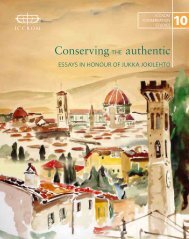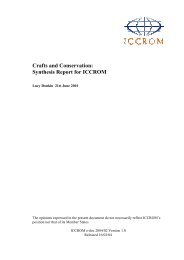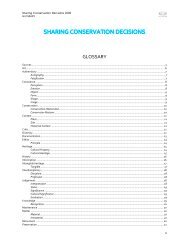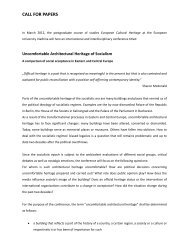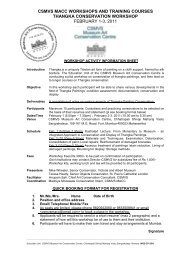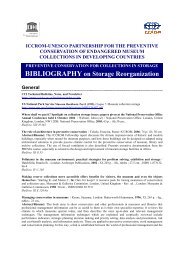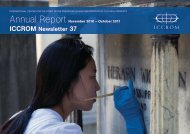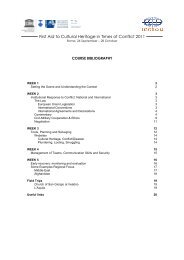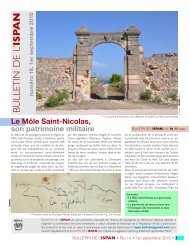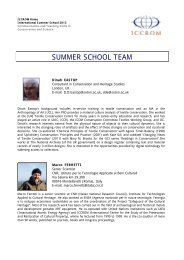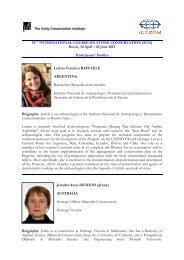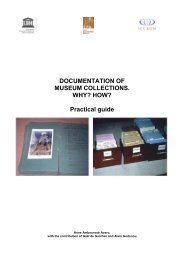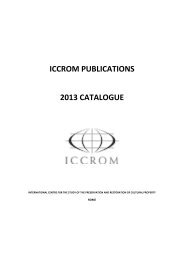part 1 - Iccrom
part 1 - Iccrom
part 1 - Iccrom
You also want an ePaper? Increase the reach of your titles
YUMPU automatically turns print PDFs into web optimized ePapers that Google loves.
Foreword<br />
ICCROM is an organization created by and for its Member States. For over half a century it has<br />
been our constant concern to maintain our relevance and usefulness for heritage institutions and<br />
professionals in different <strong>part</strong>s of the world. It is with this mandate in mind that I take great pleasure<br />
in presenting this publication, Measuring Heritage Conservation Performance, hoping it will<br />
reach the widest possible public. This volume is the compilation of the work presented at the 6 th<br />
International Seminar on Urban Conservation organized in Recife, Brazil in March 2011.<br />
In 2008, ICCROM’s regional programme for Latin America and the Caribbean LATAM chose the<br />
theme of Economic Indicators in Heritage Conservation as one of its areas of collaboration. It was<br />
recognized that such a tool was necessary in all fields of heritage, in small archives, national museums<br />
or historic towns. The pressure to be accountable, and the lack of language and terminology to<br />
talk about what we do in these terms is felt throughout the cultural heritage field. CECI (Centre for<br />
Advanced Studies in Integrated Conservation) took the leadership in addressing this issue within<br />
the LATAM programme.<br />
The seminar in Recife brought to light at least three important trends. Firstly, there is a substantial<br />
amount of work underway on this theme, both in academic and heritage settings. It is encouraging<br />
to note that the call for papers for the seminar attracted 120 proposals. Secondly, even if the seminar<br />
was organized within the framework of the regional LATAM programme, the papers proposed<br />
were from all over the world—confirming that this is an issue of interest not only to the Latin<br />
America and the Caribbean, but to colleagues and institutions worldwide. Thirdly, we have come<br />
to reconsider the title of our theme. What started out as Economic Indicators, has now matured and<br />
widened into Measuring Performance in Conservation, in recognition of the fact that the economics<br />
of conservation is only one dimension of accountability and that it is not necessarily a good thing to<br />
isolate this dimension from the wider context of social processes.<br />
Measuring and indicating are useful activities to keep track of what we are doing: are we achieving<br />
the goals we set ourselves? Equally important is communicating with decision makers and<br />
other stakeholders, expressing the essence of our actions in terms understandable to people outside<br />
of our specialized field.<br />
The diversity of approaches and the determination to come up and test different ways of measuring<br />
performance in conservation represented in these papers are a testimony of the eagerness of the<br />
heritage professionals to engage with the society at all levels. I hope sincerely that by making this<br />
body of work available we will not only encourage debate and discussion within conservation field,<br />
but also inspire engagement and <strong>part</strong>icipation of new colleagues from other areas of society, with<br />
whom we are willing and eager to join forces so as to build a more sustainable future.<br />
Mounir Bouchenaki<br />
Former Director-General, ICCROM<br />
iv



